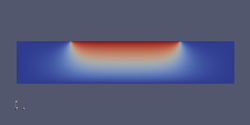Physics:Lattice Boltzmann methods for solids
The Lattice Boltzmann methods for solids (LBMS) are a set of methods for solving partial differential equations (PDE) in solid mechanics. The methods use a discretization of the Boltzmann equation(BM), and their use is known as the lattice Boltzmann methods for solids.
LBMS methods are categorized by their reliance on:
The LBMS subset remains highly challenging from a computational aspect as much as from a theoretical point of view. Solving solid equations within the LBM framework is still a very active area of research. If solids are solved, this shows that the Boltzmann equation is capable of describing solid motions as well as fluids and gases: thus unlocking complex physics to be solved such as fluid-structure interaction (FSI) in biomechanics.
Proposed insights
Vectorial distributions
The first attempt[1] of LBMS tried to use a Boltzmann-like equation for force (vectorial) distributions. The approach requires more computational memory but results are obtained in fracture and solid cracking.
Wave solvers
Another approach consists in using LBM as acoustic solvers to capture waves propagation in solids.[2][4][5][6]
Force tuning
Introduction
This idea consists of introducing a modified version of the forcing term:[7] (or equilibrium distribution[8]) into the LBM as a stress divergence force. This force is considered space-time dependent and contains solid properties[Note 1]
- [math]\displaystyle{ \vec{g} = \frac{1}{\rho} \vec{\mathbf{\nabla}_{x}} \cdot \overline{\overline{\sigma}} }[/math],
where [math]\displaystyle{ \overline{\overline{\sigma}} }[/math] denotes the Cauchy stress tensor. [math]\displaystyle{ \vec{g} }[/math] and [math]\displaystyle{ \rho }[/math] are respectively the gravity vector and solid matter density. The stress tensor is usually computed across the lattice aiming finite difference schemes.
Some results

Force tuning[3] has recently proven its efficiency with a maximum error of 5% in comparison with standard finite element solvers in mechanics. Accurate validation of results can also be a tedious task since these methods are very different, common issues are:
- Meshes or lattice discretization
- Location of computed fields at elements or nodes
- Hidden information in softwares used for finite element analysis comparison
- Non-linear materials
- Steady state convergence for LBMS
Notes
- ↑ Matter properties such as Young's modulus and Poisson's ratio.
References
- ↑ 1.0 1.1 Marconi, Stefan; Chopard, Bastien (2003). "A Lattice Boltzmann Model for a Solid Body". International Journal of Modern Physics B 17 (1n02): 153–156. doi:10.1142/S0217979203017254. ISSN 0217-9792. http://www.worldscientific.com/doi/abs/10.1142/S0217979203017254.
- ↑ 2.0 2.1 Frantziskonis, George N. (2011). "Lattice Boltzmann method for multimode wave propagation in viscoelastic media and in elastic solids". Physical Review E 83 (6): 066703. doi:10.1103/PhysRevE.83.066703. PMID 21797512.
- ↑ 3.0 3.1 Maquart, Tristan; Noël, Romain; Courbebaisse, Guy; Navarro, Laurent (2022). "Toward a Lattice Boltzmann Method for Solids — Application to Static Equilibrium of Isotropic Materials". Applied Sciences 12 (9): 4627. doi:10.3390/app12094627.
- ↑ Xiao, Shaoping (2007). "A lattice Boltzmann method for shock wave propagation in solids". Communications in Numerical Methods in Engineering (Wiley Online Library) 23 (1): 71–84. doi:10.1002/cnm.883.
- ↑ Guangwu, Yan (2000). "A Lattice Boltzmann Equation for Waves". Journal of Computational Physics 161 (1): 61–69. doi:10.1006/jcph.2000.6486. ISSN 0021-9991. http://www.sciencedirect.com/science/article/pii/S0021999100964866.
- ↑ O’Brien, Gareth S; Nissen-Meyer, Tarje; Bean, CJ (2012). "A lattice Boltzmann method for elastic wave propagation in a poisson solid". Bulletin of the Seismological Society of America (Seismological Society of America) 102 (3): 1224–1234. doi:10.1785/0120110191.
- ↑ Guo, Zhaoli; Zheng, Chuguang; Shi, Baochang (2002). "Discrete lattice effects on the forcing term in the lattice Boltzmann method". Physical Review E 65 (4 Pt 2B): 046308. doi:10.1103/PhysRevE.65.046308. PMID 12006014.
- ↑ Noël, Romain (2019). "4". The lattice Boltzmann method for numerical simulation of continuum medium aiming image-based diagnostics (PhD). Université de Lyon.
 |

